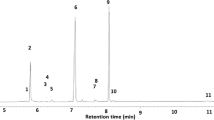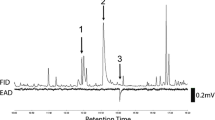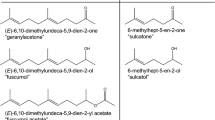Abstract
Sexually mature virgin adult males of the green stink bug, Acrosternum hilare attracted sexually mature virgin adult females in laboratory bioassays using a vertical Y-tube. There was no indication that males attracted other males, or that females attracted either sex. These results suggested that A. hilare males produce a sex pheromone. Extracts of odors collected from sexually mature males contained compounds that were not present in extracts from females or sexually immature males. (4S)-Cis-(Z)-bisabolene epoxide ((4S)-cis-Z-BAE) was the major sex-specific component of the extract. The crude extract was attractive to female A. hilare, but when separated into four fractions, only the portion containing (4S)-cis-Z-BAE and the minor component (4S)-trans-Z-BAE was attractive to females. This fraction was as attractive as the crude extract, suggesting that the former contained all the pheromone components. Neither synthetic (4S)-cis-Z-BAE nor (4S)-trans-Z-BAE alone was attractive to females, but a 95:5 cis:trans blend, mimicing the ratio naturally produced by males, was attractive to females in Y-tube bioassays. Bioassays in a field cage showed that significantly more A. hilare females were attracted to cotton string lures treated with 1 mg of a 95:5 blend of (4S)-cis-Z-BAE and (4S)-trans-Z-BAE placed inside a bouquet of alfalfa than to an alfalfa bouquet containing a pentane-treated control. In field cage studies, attraction of females was greatest during the late afternoon and evening hours, and female A. hilare approached the synthetic pheromone source almost exclusively by walking.
Similar content being viewed by others
REFERENCES
ALDRICH, J. R. 1988. Chemical ecology of the Heteroptera. Ann. Rev. Entomol. 33:211–238.
ALDRICH, J. A., LUSBY, W. R., MARRON, B. E., NICOLAOU, K. C., HOFFMANN, M. P., and WILSON, L. T. 1989. Pheromone blends of green stink bugs and possible parasitoid selection. Naturwissen. 76:173-175.
ALDRICH, J. R., HOFFMANN, M. P., KOCHANSKY, J. P., LUSBY, W. R., EGER, J. E., and PAYNE, J. A. 1991. Identification and attractiveness of a major pheromone component for Nearctic Euschistus spp. stink bugs (Heteroptera: Pentatomidae). Environ. Entomol. 20:477-483.
ALDRICH, J. R., NUMATA, H., BORGES, M., BIN, F., WAITE, G. K., and LUSBY, W. R. 1993. Artifacts and pheromone blends from Nezara spp. and other stink bugs (Heteroptera: Pentatomidae). Zeit. fur Naturforschung 48C:73-79.
ALDRICH, J. R., OLIVER, J. E., LUSBY, W. R., KOCHANSKY, J. P., and LOCKWOOD, J. A. 1987. Pheromone strains of the cosmopolitan pest, Nezara viridula (Heteroptera: Pentatomidae). J. Exp. Zool. 244:171-175.
BAKER, R., BORGES, M., COOKE, N. G., and HERBERT, R. H. 1987. Identification and synthesis of (Z)-(1'S,3'R,4'S)(-)-2-(3',4'-epoxy-4'-methylcyclohexyl)-6-methylhepta-2,5-diene, the sex pheromone of the Southern Green Stink Bug, Nezara viridula (L.). J. Chem. Soc. Chem. Comm. 1987:414-416.
BEROZA, M., and BIERL, B. A. 1969. Ozone generator for microozonolysis. Mikrochim. Acta 1969: 720-723.
BRéZOT, P., MALOSSE, C., MORI, K., and RENOU, M. 1994. Bisabolene epoxides in sex pheromone in Nezara viridula (L.) (Heteroptera: Pentatomidae): Role of cis isomer and relation to specificity of pheromone. J. Chem. Ecol. 20:3133-3147.
BUSS, A. D., GREEVES, N., MASON, R., and WARREN, S. 1987. Applications of the stereochemicallycontrolled Horner-Wittig reaction: Synthesis of feniculin, (E )-non-6-en-1-ol, a pheromone of the Mediterranean fruit fly, (E )-and (Z )-dec-5-en-1-ol, trisubstituted alkenes, and (Z )-α-bisabolene. J. Chem. Soc. Perkin Trans. I 1987:2569-2577.
CHEN, X., GOTTLIEB, L., and MILLAR J. G. 2000. Highly stereoselective syntheses of the sex pheromone components of the southern green stink bug Nezara viridula (L.) and the green stink bug Acrosternum hilare Say. Synthesis 2000:269-272.
CLARKE, R. G., and WILDE, G. E. 1970. Association of the green stink bug and the yeast-spot disease organism of soybeans. II. Frequency of transmission to soybeans, transmission from insect to insect, isolation from field population. J. Econ. Entomol. 63:355-357.
ČOKL, A., McBRIEN H. L., and MILLAR, J. G. 2001. Comparison of substrate-borne vibrational signals of two stink bug species, Acrosternum hilare and Nezara viridula (Heteroptera: Pentatomidae). Ann. Ent. Soc. Am. 94:471-479.
DAANE, K. M., STEFFAN, S. A., YOKOTA, G. Y., and MICHAILIDES, T. J. 2000. Biological investigations of hemipteran pests to improve control and reduce the spread of the fungus Botryosphaeria dothidea, pp. 119-120. California Pistachio Industry Annual Report. Crop Year 1999-2000.
da SILVA, P. G., DAANE, K. M., BEEDE, R. H., HOLTZ, B. A., and BENTLEY, W. J. 1996. Biological control of hemipteran pests of pistachio: Appearance, activity and movement of insects in the orchard, pp. 61-66. California Pistachio Industry Annual Report. Crop Year 1995-1996.
DAUGHERTY, D. M. 1967. Pentatomidae as vectors of yeast-spot disease of soybeans. J. Econ. Entomol. 60:147-152.
DELAY, F., and OHLOFF, G. 1979. Syntheses and absolute configuration of (E )-and (Z )-α-bisabolenes. Helv. Chim. Acta 62:369-377.
GILBY, A. R., and WATERHOUSE, D. F. 1965. The composition of the scent of the green vegetable bug, Nezara viridula. Proc. Royal Soc. London. Ser. (B). 162:105-120.
GREENE, J. K., TURNIPSEED, S. G., SULLIVAN, M. J., and HERZOG, G. A. 1999. Boll damage by southern green stink bug (Hemiptera: Pentatomidae) and tarnished plant bug (Hemiptera: Miridae) caged on transgenic Bacillus thuringiensis cotton. J. Econ. Entomol. 92:941-944.
HARRIS, V. E., and TODD, J. W. 1980. Male-mediated aggregation of male, female and 5th-instar southern green stink bugs and concomitant attraction of a tachinid parasite, Trichopoda pennipes. Entomol. Exp. et App. 27:117-126.
JAMES, D. G., MORI, K., ALDRICH, J. R., and OLIVER, J. E. 1994. Flight-mediated attraction of Biprorulus bibax Breddin (Hemiptera: Pentatomidae) to natural and synthetic aggregation pheromone. J. Chem. Ecol. 20:71-80.
KNOLL, W., and TAMM, C. 1975. 122. Biosynthese der verrucarine und roridine. Teil 5. Synthese von zwei diastereoisomerenpaaren des [1,8-14C]-α-bisabolols und versuche zu deren einbau in verrucarol. Helv. Chim. Acta 58:1162-1171.
KON, M., OE, A., NUMATA, H., and HIDAKA, T. 1988. Comparison of the mating behavior between two sympatric species, Nezara antennata and N. viridula (Heteroptera: Pentatomidae), with special reference to sound emission. J. Ethol. 2:91-98.
LEAL, W. S., KUWAHARA, S., SHI, X., HIGUCHI, H., MARINO, C. E. B., ONO, M., and MEINWALD, J. 1998. Male-released sex pheromone of the stink bug Piezodorus hybneri. J. Chem. Ecol. 24:1817-1829.
McBRIEN, H. L., and MILLAR, J. G. 1999. Phytophagous bugs, pp. 277-304, in J. Hardie and A. K. Minks (eds.). Pheromones of Non-Lepidopteran Insects Associated with Agricultural Crops. CAB International, Wallingford, England.
McBRIEN, H. L., RICE, R. E.,MILLAR, J. G., and McELFRESH, J. S. 1998. Male-produced sex attractant pheromone of the stink bug Thyanta pallidovirens, in Annual Meeting of the Entomological Society of America, Las Vegas, NV, Nov. 8-12, 1998. Paper 743.
MCPHERSON, J. E. 1982. The Pentatomoidea (Hemiptera) of Northeastern North America with Emphasis on the Fauna of Illinois. Southern Illinois University Press, Carbondale, IL.
MIKLAS, N., RENOU, M., ČOKL, A., and VIRANT-DOBERLET,M. 1999. Songs and pheromone interplay in sexual communication in Nezara viridula (Heteroptera: Pentatomidae), in 16th Annual Meeting of the International Society of Chemical Ecology, Marseille, Nov. 13-17, 1999. Poster # 111.
MILLAR, J. G. 1997. Methyl (2E,4Z,6Z )-deca-2,4,6-trienoate, a thermally unstable, sex-specific compound from the stink bug Thyanta pallidovirens. Tetrahedron Lett. 38:7971-7972.
MILLAR, J. G., and SIMS, J. J. 1998. Preparation, cleanup, and preliminary fractionation of extracts, pp. 1-37, in J. G. Millar and K. F. Haynes (eds.). Methods in Chemical Ecology, Vol. 1: Chemical Methods. Chapman and Hall, NY.
MINER, F. D. 1966. Biology and control of stink bugs on soybeans. Arkansas Ag. Exper. Station Bull. 708:1-40.
MORIYA, S., and SHIGA, M. 1984. Attraction of the male brown-winged green bug, Plautia stali Scott (Heteroptera: Pentatomidae) for males and females of the same species. Appl. Entomol. Zool. 19:317-322.
OTA, D., and ČOKL, A. 1991. Mate location in the southern green stink bug, Nezara viridula (Heteroptera: Pentatomidae), mediated through substrate-borne signals on ivy. J. Insect Behav. 4:441-447.
PANIZZI, A. R. 1997. Wild hosts of pentatomids: Ecological significance and role in their pest status on crops. Annu. Rev. Entomol. 42:99-122.
RICE, R. E., BENTLEY,W. J., and BEEDE, R. H. 1988. Insect and mite pests of pistachios in California. University of California. Division of Agriculture and Natural Resources Publication 21452.
RYAN, M. A., MOORE, C. J., and WALTER, G. H. 1995. Individual variation in pheromone composition in Nezara viridula (Heteroptera: Pentatomidae):Howvalid is the basis for designating “pheromone strains”? Comp. Biochem. Physiol B 111:189-193.
SIMMONS, A. M., and YEARGAN, K. V. 1988. Development and survivorship of the green stink bug, Acrosternum hilare (Hemiptera: Pentatomidae) on soybean. Environ. Entomol. 17:527-532.
STADDON, B. W. 1979. The scent glands of Heteroptera. Advanced Insect Physiol. 14:351-418.
STEEL, R. G. D., TORRIE, J. H., and DICKEY, D. A. 1997. Principles and Procedures of Statistics. A Biometrical Approach, 3rd edn. McGraw-Hill, New York.
SUGIE, H., YOSHIDA, M., KAWASAKI, K., NOGUCHI, H., MORIYA, S., TAKAGI, K., FUKUDA, H., FUJIIE, A., YAMANAKA, M., OHIRA, Y., TSUTSUMI, T., TSUDA, K., FUKUMOTO, K., YAMASHITA, M., and SUZUKI, H. 1996. Identification of the aggregation pheromone of the brown-winged green bug, Plautia stali Scott (Hemiptera: Pentatomidae). Appl. Entomol. Zool. 31:427-431.
TOMIOKA, H., and MORI, K. 1992. Simple synthesis of a diastereomeric mixture of 2-(3',4'-epoxy-4'-methylcyclohexyl)-6-methyl-2,5-heptadiene, the pheromone of the green stink bug. Biosci. Biotech. Biochem. 56:1001.
TURNIPSEED, S. G., and GREENE, J. K. 1996. Strategies for managing stink bugs in transgenic B.T. cotton, pp. 935-936, in Proc. 1996 Beltwide Cotton Conference, National Cotton Council of America, Memphis, TN.
Author information
Authors and Affiliations
Rights and permissions
About this article
Cite this article
Mcbrien, H.L., Millar, J.G., Gottlieb, L. et al. Male-Produced Sex Attractant Pheromone of the Green Stink Bug, Acrosternum hilare (Say). J Chem Ecol 27, 1821–1839 (2001). https://doi.org/10.1023/A:1010460709535
Issue Date:
DOI: https://doi.org/10.1023/A:1010460709535




